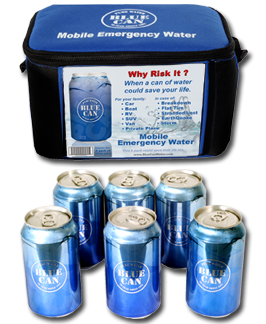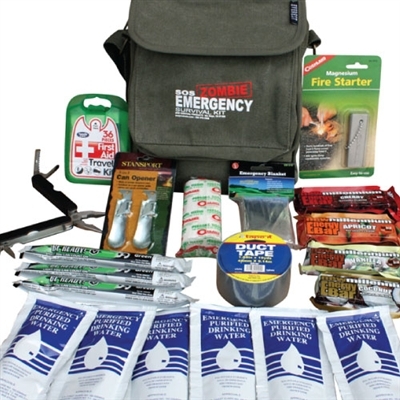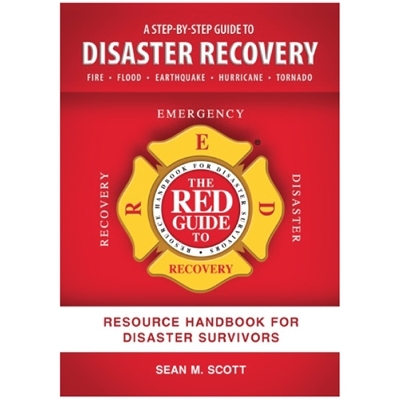"Don't get scared - get prepared," says Los Angeles-based disaster preparedness teacher, Deidra Dwyer, who adds that despite Southern California being "eighteen months pregnant" for a major earthquake, only two in every ten Angelenos are even somewhat ready, and that's an optimistic number.
With more than 300 faults in The City of Angels, you can't get more than 10 miles away from a fault. "The chances for another Northridge-sized quake to occur is 99.9%," notes Lucy Jones, government seismologist.
So how do Angelenos become ready for a disaster, earthquake or otherwise? Here are ten quick tips that can save your life and the lives of others...
1: The S.O.S. Store in Van Nuys, and other area supply shopsPay a visit to the store that Dwyer and other prepared individuals call their "toy shop." Run by Jeff Edelstein, the S.O.S. Store (15705 Strathern Street, Van Nuys 91406) is the city's premiere one-stop destination for emergency supplies. Obscurely located on a side street blocks west of the 405, this no-frills boutique should be on the radar of every Angeleno. It offers a wide variety of highly recommended preparedness classes - some of them for free. The store is also stocked and ready for El Nino. With massive rainfall predicted from late December through March, S.O.S. has all the extreme weather rain gear you'll need (boots, rain suits, sand bags, tarps, ropes, lanterns, batteries, power failure lights), and if you have a yard or pool prone to flooding, a sump pump and flood buckets. If Van Nuys is a challenge to get to, Dollar Tree or 99 Cent Stores are great places for cost effective tools, gloves, First Aid. Also try Home Depot, Army Navy Stores, surplus stores, and yard sales for a bonanza of emergency gear. 2. Water Humans can survive for more than three weeks without food, but water is the most primary element to human survival, second only to air. Mahatma Gandhi survived 21 days of complete starvation, but the maximum an individual can survive without water is 3 days, an estimate that would certainly be shorter in boiling heat or extreme cold. With bottled water having only a 6 to 12 month shelf life, the longest lasting water product on the market for our dream emergency disaster shelter, is L.A.-based Blue Can Water. Boasting a fifty year shelf life and standards that exceed FDA regulations and bottled water industry standards, Blue Can stays 100% pure and fresh for decades. Photo courtesy of Doris Bergman
3. Protect your head, hands, and feet...
Dwyer advises:
Protect your head from falling debris - that's number one. If you are inside a building, get in an interior corner away from windows. In a high rise, the safest place is in the core of the building near the elevators usually because that's where most structure is. Don't run outside during the shaking. You are unsteady on your feet - things are falling. If you're outdoors when a major quake strikes, get into as open an area as you can away from buildings that have glass or brick that can shatter or fall on you. I actually put handles under my desk at work. I bring my drill and install handles, and when I move onto another job, I take them with me. Think about it. I don't want to hold onto the edge of my desk because we have computers and things that can fall and break your fingers. In a major quake, the desk may be moving around the room and you need something steady to hold onto. Stepping on glass or getting your hands hurt is what you must avoid. If you hurt your feet or your hands in a disaster, you not only injure yourself, but you've become a casualty for the able bodied people to take care of.
Sturdy shoes are must-haves to help navigate around debris because the biggest causes of injuries in a home or workplace in a quake are bookshelves, china cabinets and large mirrors that aren't properly secured.
4. Be organized and have a plan...Because families are often separated in disasters, coordinate a plan that involves multiple forms of communication including a real-world meeting place, such as a park or schoolyard. In general, neighborhood parks or schoolyards are open spaces away from harm (fewer high-rise buildings or power lines, etc). And know the answers to these questions:- What's your plan if your kids are at school when a disaster strikes? - Where is your safe meeting place?- Who is your out of state contact?- Do you know about your utilities?- How do you take care of your pets? - Do you know where your important documents are such as insurance policies, bank account information, ID cards and photographs to help identify the missing. Planning makes all the difference - again, don't get scared, get prepared.
5. TrainingWhen was your last First Aid, fire safety, Ham Radio or CPR training class? Classes are readily available all over the city - sign up with a group of friends. Also, you can learn basic First Aid tips from videos on Youtube. Ham Radio workshops are offered at the S.O.S. Store, and if you haven't seen Ham Radios recently, they can be pocket-sized and are the closest thing to foolproof in an emergency.
Dwyer says:
Think about the places where you spend your time. If you're at the gym when disaster strikes do they have First Aid kits or is there someone with First Aid training?" And while you're at it, just get in better shape to be more ready.
6. Landline phones, and keep vehicles fueled up!Keep your vehicle's gas no less than half full. If a major quake hits, gas stations and cell phone towers will stop being operational.
Dwyer adds:
Most cell phone towers have backup generators but those will stop after three or four days. Landline phones are much more reliable. Texting on a cell may actually still go through whereas calling won't work after a major quake. As far as phones go, one of the most reliable phones is a pay phone and I bet you most people today don't know where the nearest working pay phone is located. Keep a few quarters because odds are the payphone will still be working. Gas station pumps require electricity so even if the stations have gas, you're not going to be able to pump it.
7. CASHHave about fifty one dollar bills stashed away or in your preparedness kit.
Dwyer notes:
After a disaster, if you go to 7-11 and need to buy water, assuming they even have any left, it's not going to be $1.99. Cash registers will not be operational so if all you have is a twenty then they will take your twenty. You need to have many singles on hand.
8. Have kits ready!Individuals shouldn't have just one emergency kit. They should have three -- at home, at work and in their cars. Kits should be assembled to last a minimum of three days, and, optimally, two weeks. And consider also creating a "Personal Care Kit" to include hygiene, glasses, whatever you need to take care of your own well being.
A fun gift idea is S.O.S. Store's Zombie Apocalypse Preparedness Kit. Essentially, your basic supplies kit stocked with water packets, food, etc. for The Walking Dead fans in your life.
9. Keep paper maps and one of these two books...We are so reliant on the Internet or GPS for all information these days, but paper books and paper maps will be your best allies after a major power outage. The Red Guide To Recovery Book and The Los Angeles County Emergency Survival Guide are the ultimate preparedness manuals - available at the S.O.S. Store.
10. Dirt bikes, camping gear and flashlightsIn a severe quake where roads are destroyed and fractured, any vehicle larger than a dirt bike may be useless. Those who are able bodied enough to climb or hike will be the best off.
Dwyer concludes with:
If you are already into camping, you're there. You have tents, you have equipment, much of it can be used in a disaster, and you are used to roughing it. A tent, lantern, and portable camping stove are well worth it.
And consider, how many working flashlights do you have? And do you know where they are? Keep one in your car at all times. Also highly recommended is a Power Failure Light (available at S.O.S. Store). Keep it plugged in to charge, and when the power goes out - the room will be flooded automatically with bright light. Stays charged for 12 hours and can be used as a flashlight. Also consider, a radio-flashlight combo that is either crank or solar or battery.
I leave you with some interesting recent statistics conducted recently by Loyola Marymount University. When Angelenos were asked how prepared they are for disaster, the groups with the highest rates of belief in their preparedness were military/veterans (35.8 percent), Conservatives (33 percent), and the LGBT community (32.5 percent). Most other groups fell far short of these numbers. And according to a survey by the county Department of Public Health, only 6 percent of Los Angeles county residents said they are completely prepared to deal with a major natural disaster.
Let's get prepared, Los Angeles!


